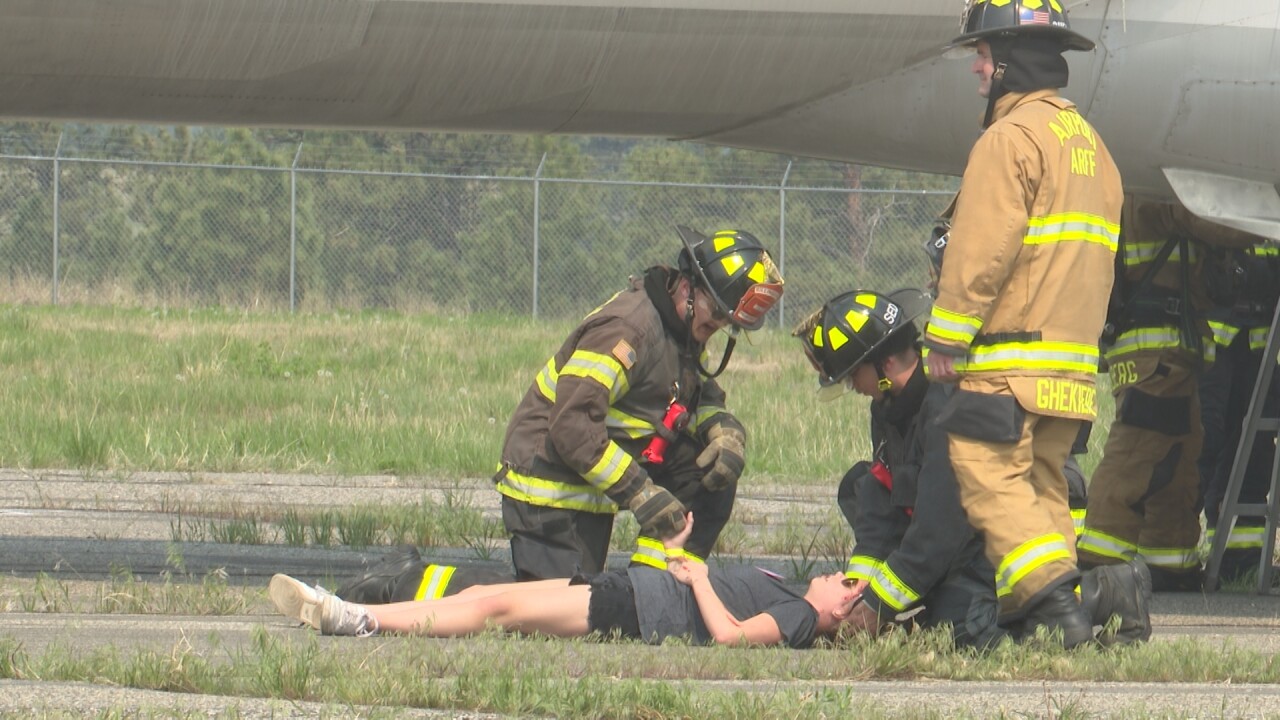BILLINGS — On Thursday at the Billings-Logan International Airport, smoke filled the runways. But it wasn't an accident—it was part of a mass casualty crisis simulation training.
“We’re trying to get as close as we possibly can to what an actual aircraft emergency would be like," said Shane Ketterling, the assistant director of aviation and transit at the airport, on Thursday. "It’s essentially all the responders who would participate. Airport, fire, Billings Fire Department, mutual aid agencies. We could call on Lockwood or Laurel. AMR. Anyone and everyone if there was an aircraft incident or accident."

It was a way to practice and prepare for whatever might happen by acting out a plane crash. Crisis actors were brought in to add realism.
“Our employees train nonstop for an aircraft accident, and so this is basically to simulate the passengers on an aircraft and how we would handle that type of incident," Ketterling said. “We just want the community to be aware that we do everything possible to keep everyone on aircraft as safe as they can possibly be."
Every three years, the Federal Aviation Administration requires these drills to be held to ensure cities and airports are prepared for the worst possible scenario.

“Rest assured if something did occur on the airport, we have first responders who will be there immediately to take care of them,” Ketterling said. “Basically it all revolves around life safety."
And responders showed up in full force: Billings, Lockwood, and Laurel fire, EMS, and Billings hospitals participated.
"It’s one of those things that’s very vital for our community as a resource, and a commitment to our community to be able to handle that day when it comes to us," said Dr. Barry McKenzie, the trauma medical director and a trauma surgeon at St. Vincent Healthcare, on Thursday. "Unfortunately in this day and age, I think we all feel like it’s going to happen sometime. These kinds of drills really kind of start to hone in on the things we need to work on and make better."

McKenzie said months of planning lead up to the drill.
“Months and months of planning between, what does the exercise look like, what kind of patients are we going to anticipate, what is the planning? As far as how far into the facility do we want to take this, do we just want to stay in the (Emergency Department), do we want to expand it to the (Operating Room), all the way to the (Intensive Care Unit)?” McKenzie said. “I think (it's) as real as you can get."
The day was filled with different emotions.
“It’s stressful because you want to do a good job, but you also know we’re going to have opportunities for improvement. We get to learn from this part. And so those are the hard things," McKenzie said. "We want to get everything right all the time, but no one’s been faced with this kind of situation in this community yet. And so we know there’s going to be issues, and so we need to identify those."
Over at Billings Clinic, Dr. Jamiee Belsky had her hands full between patients and actors.
“Just because there’s a drill, just because there’s a mass casualty event, it doesn’t mean that the heart attacks stop, it doesn’t mean that people don’t get strokes," Belsky, the emergency department medical director at Billings Clinic, said on Thursday. "So you’ll still have people coming in the front door. So this is a great way to test our system, see what objectives that we have that are working and not working."

The drill is meant to be as realistic as possible, happening on a day when the hospitals were already busy.
“You help identify these things ahead of time, so god forbid when the real disaster happens, boom. You’re on it, your team is ready to go,” Belsky said. “Every time we do one of these, there are at least 10 action items that come out of there about ways we can improve."

And practice makes perfect.
To learn more about the drill, click here.
"When the real disaster happens, you've already moved people in real-time. It helps you improve so much better," Belsky said. "A lot of these people are volunteering to be here today, to work double shifts. Not only to see real patients, but to participate in the drill and make it safer for our community. So just want to say thank you to the whole team for doing this."





